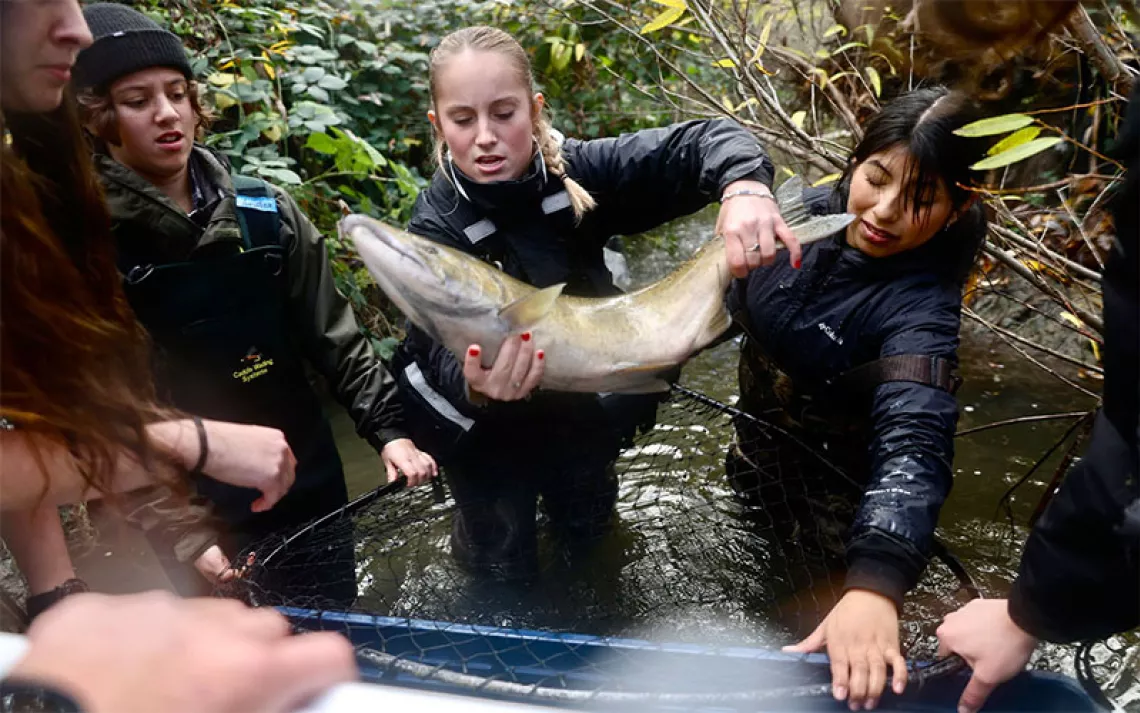Gray Wolves Will No Longer Have Federal Protection
The Trump administration removes the still-recovering apex predator from the endangered species list

Photo by AP Photo/Colorado Parks and Wildlife
This article was published jointly with Earth Island Journal.
On October 29, in a move that seems aimed at appeasing ranchers and hunters just days ahead of the presidential election, the Trump administration finalized a controversial rule that removes Endangered Species Act (ESA) protections for all gray wolves in the lower 48 states, excepting Mexican gray wolves in Arizona and New Mexico. The move, long in the making, turns over management of this imperiled species to states and tribal governments.
“After more than 45 years as a listed species, the gray wolf has exceeded all conservation goals for recovery,” Secretary of the Interior David Bernhardt said in a press statement announcing the decision last Thursday. “Today’s announcement simply reflects the determination that this species is neither a threatened nor endangered species based on the specific factors Congress has laid out in the law.” The press release was fortified with supportive quotes from senators, congressional representatives, governors, and county commissioners, most of them from western states.
A chorus of conservation groups immediately decried the delisting as premature and vowed to challenge the decision in court. They argue that the Endangered Species Act requires a species to be recovered through a significant portion of its range before removing federal protections, and that hunting, trapping, poaching, and vehicle collisions pose real threats to recovery where populations are small.
Wolves have only reoccupied about 10 percent of their historic range in the Lower 48, asserts Defenders of Wildlife.
“If you look at the amount of suitable habitat and how much has been reoccupied, it’s fairly low,” says Sristi Kamal, senior representative for the group’s Northwest Program. She points to Colorado as an example. The state has an abundance of good wolf habitat but no established packs.
Now is the time for environmental journalism.
Sign up for your Sierra magazine subscription.

A key predator species, wolves once roamed freely throughout the United States. But by the early 20th century, wolves were nearly exterminated in the contiguous United States. As human populations extended farther into the American wilderness, wolves were hunted nearly to extinction—largely because they posed a threat to ranchers’ livestock. By the 1960s, when wolves finally received some federal protection, they had become ecologically extinct, meaning they were no longer playing a role in maintaining the ecosystem. Only a small population survived in northern Minnesota and on Isle Royale, Michigan. In 1974, the gray wolf was listed as endangered under the ESA.
In 1995, 66 gray wolves were brought from Canada and reintroduced in central Idaho and Yellowstone. Since then, the population in the Northern Rockies has expanded, and wolves have begun dispersing into the Pacific Northwest and California. According to the US Fish and Wildlife Service, there are now an estimated 6,000 wolves in the lower 48 states.
Since 2000, there have been numerous attempts to remove or reduce federal protections for wolves (check out the wolf wars timeline here). In fact, wolves were delisted in Idaho, Montana, Wyoming, and parts of Oregon and Washington in 2011, leaving wolf management up to those states.
Suzanne Stone, cofounder of the Wood River Wolf Project, cites Idaho as a good example of what happens when federal protections are removed. “Since the US Fish and Wildlife Service stopped providing oversight and requiring mandatory reports, we’ve seen a major attack on the wolf population,” she says.
This includes year-round hunting and bounties on wolves, which don’t exclude nursing females and their young pups. Within the 12-month period ending on June 30, 2020, alone, 570 wolves were killed in Idaho. Nearly 3,500 wolves have been killed in Idaho, Montana, and Wyoming since 2011.
Killing wolves can destabilize packs and potentially lead to more depredations on livestock, says Stone. “This gives the state more reason to kill more wolves. It becomes this really vicious cycle.”
The Trump administration’s decision undermines collaborative efforts to reduce wolf-livestock conflicts without killing wolves.
“In areas where wolves are federally listened, lethal control is not an option,” says Kamal. “This has opened up conversations around how we can use nonlethal strategies.” Some states, such as Oregon, require that such strategies be tried first, even where lethal control is allowed. But most others do not.
Removing the overlay of federal protection subjects wolves to a patchwork of state management policies. And since wolves routinely disperse from areas of higher to lower concentration, management in one state will impact the species’ success in another, especially in states like California and Colorado, which currently have few to no established packs.
In addition to jeopardizing further recovery of the gray wolf, the premature delisting also has dire implications for the hundreds of endangered species that rely on proper implementation of the ESA for protection while they recover.
Earthjustice will likely lead the legal challenge against this move.
“This is no ‘Mission Accomplished’ moment for wolf recovery,” Kristen Boyles, an Earthjustice attorney, said in a statement. “Wolves are only starting to get a toehold in places like Northern California and the Pacific Northwest, and wolves need federal protection to explore habitat in the Southern Rockies and the Northeast. This delisting decision is what happens when bad science drives bad policy—and it’s illegal, so we will see them in court.”
Defenders of Wildlife will join the litigation but will also continue working with state agencies and producers on the ground to encourage the use of nonlethal strategies.
“It’s a setback, and disheartening, but the best approach is to continue outreach and engagement and spread the message about how lethal control will not solve the problems producers face,” says Kamal.
The delisting comes at a time when public support for protecting wolves is strong.
After the Department of Interior announced its proposed rule to delist gray wolves everywhere except for in Arizona and New Mexico in March 2019, the comment period generated hundreds of thousands of public comments, most of them opposed to the rule.
Scientific peer reviews commissioned by the Fish and Wildlife Service, too, found that the agency’s proposal contained numerous errors and appeared to come to a predetermined, erroneous conclusion that wasn’t supported by science.
This latest decision, announced less than a week before Election Day and scheduled to go into effect 60 days after publication in the federal register (it is scheduled to be published tomorrow, on Election Day), is sure to play well in conservative western states.
Stone urges those who care about the iconic predators to “be the true voice for wolves.” Vote; hold state fish and wildlife commissions and agencies accountable; and take every opportunity for public comment and engagement to help save this keystone species.
 The Magazine of The Sierra Club
The Magazine of The Sierra Club



